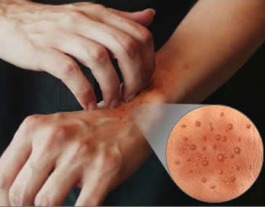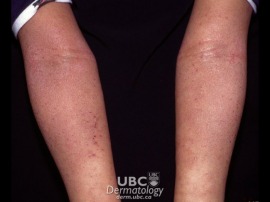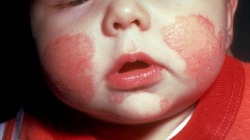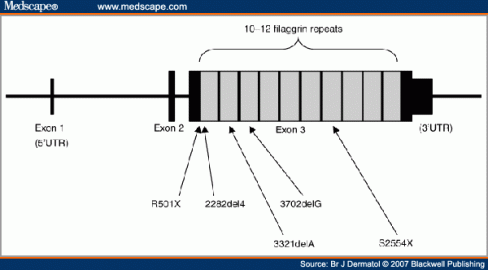Eczema & Filaggrin
Genetic Factors in Atopic Dermatitis
This site was produced as an assignment for Genetics 677, an undergraduate course at UW-Madison (Sp'10)
Introduction
Prevalent in over one-tenth of children, eczema is a common skin condition that is characterized by chronic dry skin prone to irritation and redness. Also known as atopic dermatitis, the rashes caused by eczema are often found in the folds of the elbows and knees, as well as on the face and in various areas of the body. Typically, the condition is observed from birth, while few cases manifest in adulthood. The disease is not contagious, but is believed to be transmitted by some genetic mechanism through heredity and can be triggered by an allergic reaction or immuno-response.
Prevalence
The condition is seen most frequently in newborns and babies, but rarely in adults. Found in slightly higher frequencies in females over males, about 85% of eczema cases are identified in children under the age of one year. Typically disappearing as the individual approaches adolescence, eczema is seen in children at a rate of 10-12%, with estimates as high as 20%, and less than 1% in individuals over the age of eighteen years. [1] A 2007 study of 116,202 Americans revealed that 10.7% of those tested reported empirically defined eczema, with prevalence decreasing in wealthier individuals. [2] The study concluded that a notable portion of the American public suffers from eczematous symptoms, while the disease has been shown to have increased in frequency over the last three decades. [3]
Treatment
Dermatologists and patients suffering from eczema use a very wide range of methods in dealing with the condition. In addition, different treatments tend to work in variably from patient to patient. According to MayoClinic.com, common medications include corticosteroids, antibiotics, and antihistamines. As outlined in the NICE (The National Institue for Health and Clinical Excellence) “Guidelines Issued for Treating Atopic Eczema in Children”, frequent and consistent moisturizing of affected areas is important for those experiencing the disease, while some believe various diet restrictions can aid in relief from symptoms.
Prevalence
The condition is seen most frequently in newborns and babies, but rarely in adults. Found in slightly higher frequencies in females over males, about 85% of eczema cases are identified in children under the age of one year. Typically disappearing as the individual approaches adolescence, eczema is seen in children at a rate of 10-12%, with estimates as high as 20%, and less than 1% in individuals over the age of eighteen years. [1] A 2007 study of 116,202 Americans revealed that 10.7% of those tested reported empirically defined eczema, with prevalence decreasing in wealthier individuals. [2] The study concluded that a notable portion of the American public suffers from eczematous symptoms, while the disease has been shown to have increased in frequency over the last three decades. [3]
Treatment
Dermatologists and patients suffering from eczema use a very wide range of methods in dealing with the condition. In addition, different treatments tend to work in variably from patient to patient. According to MayoClinic.com, common medications include corticosteroids, antibiotics, and antihistamines. As outlined in the NICE (The National Institue for Health and Clinical Excellence) “Guidelines Issued for Treating Atopic Eczema in Children”, frequent and consistent moisturizing of affected areas is important for those experiencing the disease, while some believe various diet restrictions can aid in relief from symptoms.
Filaggrin Gene
Recent studies have identified mutations in the gene filaggrin to be associated with occurences of eczema. This gene, also referred to as FLG, produces the protein filaggrin, known to be involved in the production of the epidermis. Null carriers of the protein exhibit defects in the skin barrier and two loss-of-function mutations of the gene, R510X and 2282del4, have been found to have strong correlations with displays of eczema. [4]
Further Resources on the FLG gene:
BLAST
GeneCards
Sources
- eMedicine. (2010). Atopic Dermatitis. Retrieved February 9, 2010, from http://emedicine.medscape.com/article/1049085- overview
- Hanifin JM, Reed ML. A population-based survey of eczema prevalence in the United States. Dermatitis. 2007;18:82–91. [PubMed]
- DiepgenT.Is the prevalence of atopic dermatitis increasing? In: WilliamsHCAtopic Dermatitis.Cambridge: Cambridge University Press, 2000: 96–112.
- Palmer CN, Irvine AD, Terron-Kwiatkowski A, et al. (2006). "Common loss-of-function variants of the epidermal barrier protein filaggrin are a major predisposing factor for atopic dermatitis". Nat. Genet. 38 (4): 441–6. doi:10.1038/ng1767





